Embedding Civil Engineering Understanding through the Use of Interactive Virtual Reality
Abstract
:1. Introduction
2. Review of the Literature
2.1. Intro to VR
2.2. VR as a Method of Teaching
2.3. VR in Civil Engineering Education
3. Materials and Methods
3.1. Hardware Specifications
3.2. Development of the Application
3.3. Questionnaire
3.4. Collection of Data
3.5. Ethical Approval
4. Results
4.1. Results of the Questionnaire
4.2. Comparison of Results with the Recorded Lab during 2022–2021 and the In-Person Lab during 2022–2023
5. Conclusions
Author Contributions
Funding
Institutional Review Board Statement
Informed Consent Statement
Data Availability Statement
Acknowledgments
Conflicts of Interest
References
- McComb, C.; Tehrani, F.M. Research and Practice Group Methodology: A Case Study in Student Success. In Proceedings of the 2014 ASEE Pacific-Southwest Conference, San Diego, CA, USA, 24–26 April 2014. [Google Scholar] [CrossRef]
- Tehrani, F.M.; McComb, C.; Scott, S. A Quantitative Approach to Evaluate the Application of the Extended Situational Teaching Model in Engineering Education. Stats 2021, 4, 46–61. [Google Scholar] [CrossRef]
- Tito-Izquierdo, J.; Gomez-Rivas, A.; Pincus, G. Teaching modern concrete technology at the university of Houston-Downtown. In ASEE Annual Conference and Exposition, Conference Proceedings; American Society for Engineering Education: Washington, DC, USA, 2005; pp. 13951–13959. [Google Scholar] [CrossRef]
- Arsad, N.; Sanusi, H.; Majid, R.A.; Ali, M.M.; Husain, H. Lateral Thinking through Black Box Experiment among Engineering Students. Procedia Soc. Behav. Sci. 2012, 60, 14–20. [Google Scholar] [CrossRef]
- Hamid, R.; Baharom, S.; Taha, M.R.; Kasim, A.A.A. Sustainable and Economical Open-Ended Project for Materials Technology Course Laboratory Work. Procedia Soc. Behav. Sci. 2012, 60, 3–7. [Google Scholar] [CrossRef]
- Baharom, S.; Hamid, R.; Hamzah, N. Development of a Problem based Learning in Concrete Technology Laboratory Work. Procedia Soc. Behav. Sci. 2012, 60, 8–13. [Google Scholar] [CrossRef]
- Cooper, H.M. Organizing knowledge syntheses: A taxonomy of literature reviews. Knowl. Soc. 1988, 1, 104–126. [Google Scholar] [CrossRef]
- Zheng, J.M.; Chan, K.W.; Gibson, I. Virtual reality. IEEE Potentials 1998, 17, 20–23. [Google Scholar] [CrossRef]
- Heilig, M.L. Sensorama Simulator. U.S. Patent US3050870A, 28 August 1962. [Google Scholar]
- Heilig, M.L. Stereoscopic-Television Apparatus for Individual Use. U.S. Patent US2955156A, 4 October 1960. [Google Scholar]
- Bell, J.T.; Fogler, H.C. The application of virtual reality to (chemical engineering) education. In IEEE Virtual Reality; IEEE: Piscataway, NJ, USA, 2004; pp. 217–218. [Google Scholar] [CrossRef]
- Codd, A.M.; Choudhury, B. Virtual reality anatomy: Is it comparable with traditional methods in the teaching of human forearm musculoskeletal anatomy? Anat. Sci. Educ. 2011, 4, 119–125. [Google Scholar] [CrossRef] [PubMed]
- Duarte, M.L.; Santos, L.R.; Guimarães, J.B., Jr.; Peccin, M.S. Learning anatomy by virtual reality and augmented reality. A scope review. Morphologie 2020, 104, 254–266. [Google Scholar] [CrossRef] [PubMed]
- Freina, L.; Ott, M. A Literature Review on Immersive Virtual Reality in Education: State of The Art and Perspectives. In Proceedings of the International Scientific Conference eLearning and Software for Education, Bucharest, Romania, 23–24 April 2015; pp. 133–141. [Google Scholar] [CrossRef]
- Pridhvi Krishna, M.V.; Mehta, S.; Verma, S.; Rane, S. Mixed Reality in Smart Computing Education System. In Proceedings of the 2018 International Conference on Smart Systems and Inventive Technology (ICSSIT), Tirunelveli, India, 13–14 December 2018; IEEE: Piscataway, NJ, USA, 2018; pp. 72–75. [Google Scholar] [CrossRef]
- Hong, X.; Lv, B. Application of Training Simulation Software and Virtual Reality Technology in Civil Engineering. In Proceedings of the 2022 IEEE International Conference on Electrical Engineering, Big Data and Algorithms (EEBDA), Changchun, China, 25–27 February 2022; IEEE: Piscataway, NJ, USA, 2022; pp. 520–524. [Google Scholar] [CrossRef]
- Soliman, M.; Pesyridis, A.; Dalaymani-Zad, D.; Gronfula, M.; Kourmpetis, M. The Application of Virtual Reality in Engineering Education. Appl. Sci. 2021, 11, 2879. [Google Scholar] [CrossRef]
- David, J.; Lobov, A.; Lanz, M. Learning experiences involving digital twins. In Proceedings of the IECON 2018—44th Annual Conference of the IEEE Industrial Electronics Society, Washington, DC, USA, 21–23 October 2018; pp. 3681–3686. [Google Scholar] [CrossRef]
- McCabe, A.; Mcpolin, D.O. Virtual reality: Immersed in the structural world. Struct. Eng. 2015, 93, 20–23. [Google Scholar]
- Sampaio, A.Z.; Viana, L. Virtual Reality technology used as a learning tool in Civil Engineering training. In Proceedings of the 2014 7th International Conference on Human System Interactions (HSI), Lisbon, Portugal, 16–18 June 2014; IEEE: Piscataway, NJ, USA, 2014; pp. 156–161. [Google Scholar] [CrossRef]
- Dinis, F.M.; Guimaraes, A.S.; Carvalho, B.R.; Pocas Martins, J.P. Virtual and augmented reality game-based applications to civil engineering education. In Proceedings of the 2017 IEEE Global Engineering Education Conference (EDUCON), Athens, Greece, 26–28 April 2017; IEEE: Piscataway, NJ, USA, 2017; pp. 1683–1688. [Google Scholar] [CrossRef]
- Liang, L.M. Applied Research of VR Technology in Civil Engineering Teaching. In Proceedings of the 2021 International Conference on Internet, Education and Information Technology (IEIT), Suzhou, China, 16–18 April 2021; IEEE: Piscataway, NJ, USA, 2021; pp. 477–480. [Google Scholar] [CrossRef]
- Walker, J.; Stepanov, D.; Towey, D.; Elamin, A.; Pike, M.; Wei, R. Creating a 4D Photoreal VR Environment to Teach Civil Engineering. In Proceedings of the 2019 IEEE International Conference on Engineering, Technology and Education (TALE), Yogyakarta, Indonesia, 10–13 December 2019; IEEE: Piscataway, NJ, USA, 2019; pp. 1–8. [Google Scholar] [CrossRef]
- Wang, Y. Application of Virtual Reality Technique in the Construction of Modular Teaching Resources. Int. J. Emerg. Technol. Learn. (iJET) 2020, 15, 126. [Google Scholar] [CrossRef]
- Zacher, S. Digital Twins for Education and Study of Engineering Sciences. Int. J. Eng. 2020, 2, 61–69. [Google Scholar] [CrossRef]
- Try, S.; Panuwatwanich, K.; Tanapornraweekit, G.; Kaewmoracharoen, M. Virtual reality application to aid civil engineering laboratory course: A multicriteria comparative study. Comput. Appl. Eng. Educ. 2021, 29, 1771–1792. [Google Scholar] [CrossRef]
- Meta. Meta Quest 2. Available online: https://www.meta.com/gb/quest/products/quest-2/?gclid=Cj0KCQjwtO-kBhDIARIsAL6LoreH7Xn5TpRQCRtXMb-npqtecTGLD-AMYoq2EbSyrdd9Mk1OLwPBHTcaAjNCEALw_wcB (accessed on 22 September 2023).
- EN 1992-1-1; Eurocode 2: Design of Concrete Structures—Part 1-1: General Rules and Rules for Buildings; Bridges and Civil Engineering Structures. European Committee for Standardization: Brussels, Belgium, 2021.
- Smyth, L.; Mavor, K.I.; Platow, M.J.; Grace, D.M.; Reynolds, K.J. Discipline social identification, study norms and learning approach in university students, study norms and learning approach in university students. Educ. Psychol. 2015, 35, 53–72. [Google Scholar] [CrossRef]
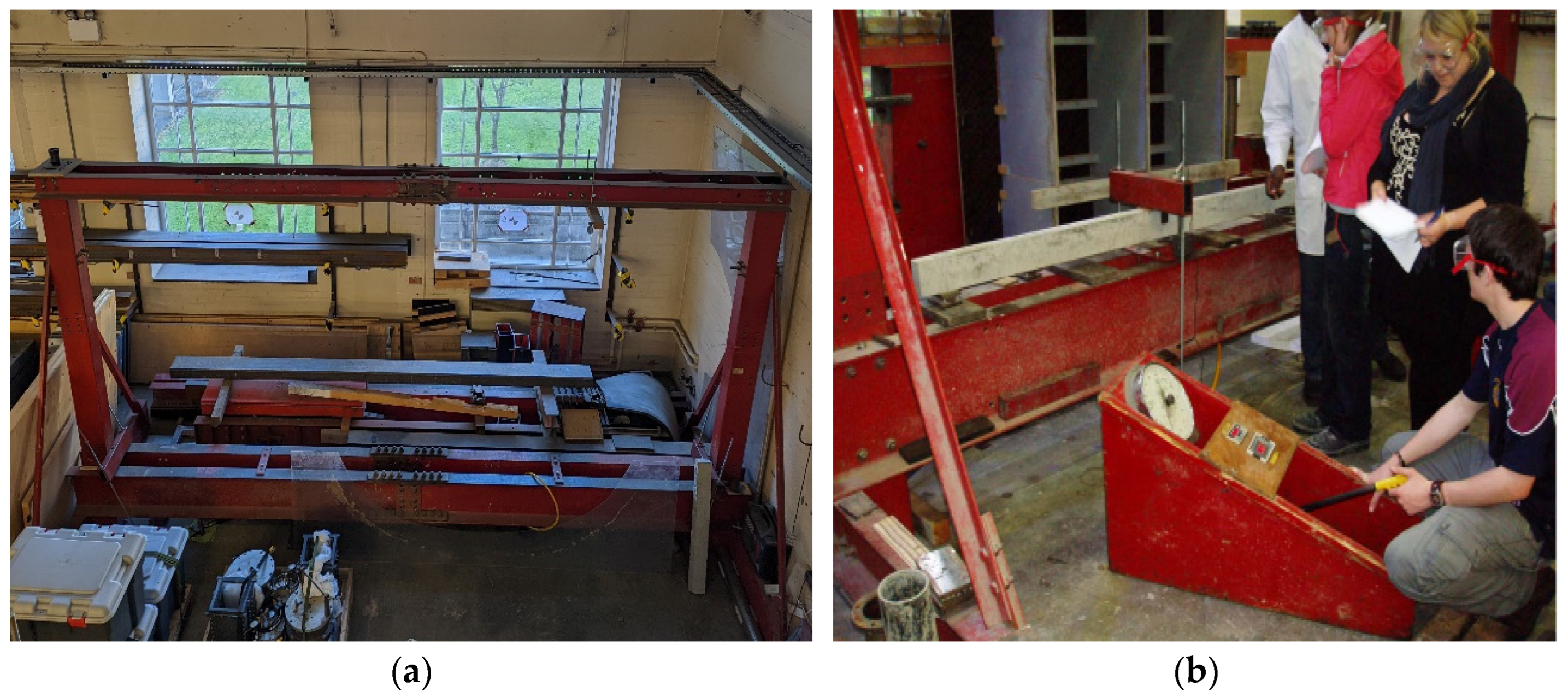
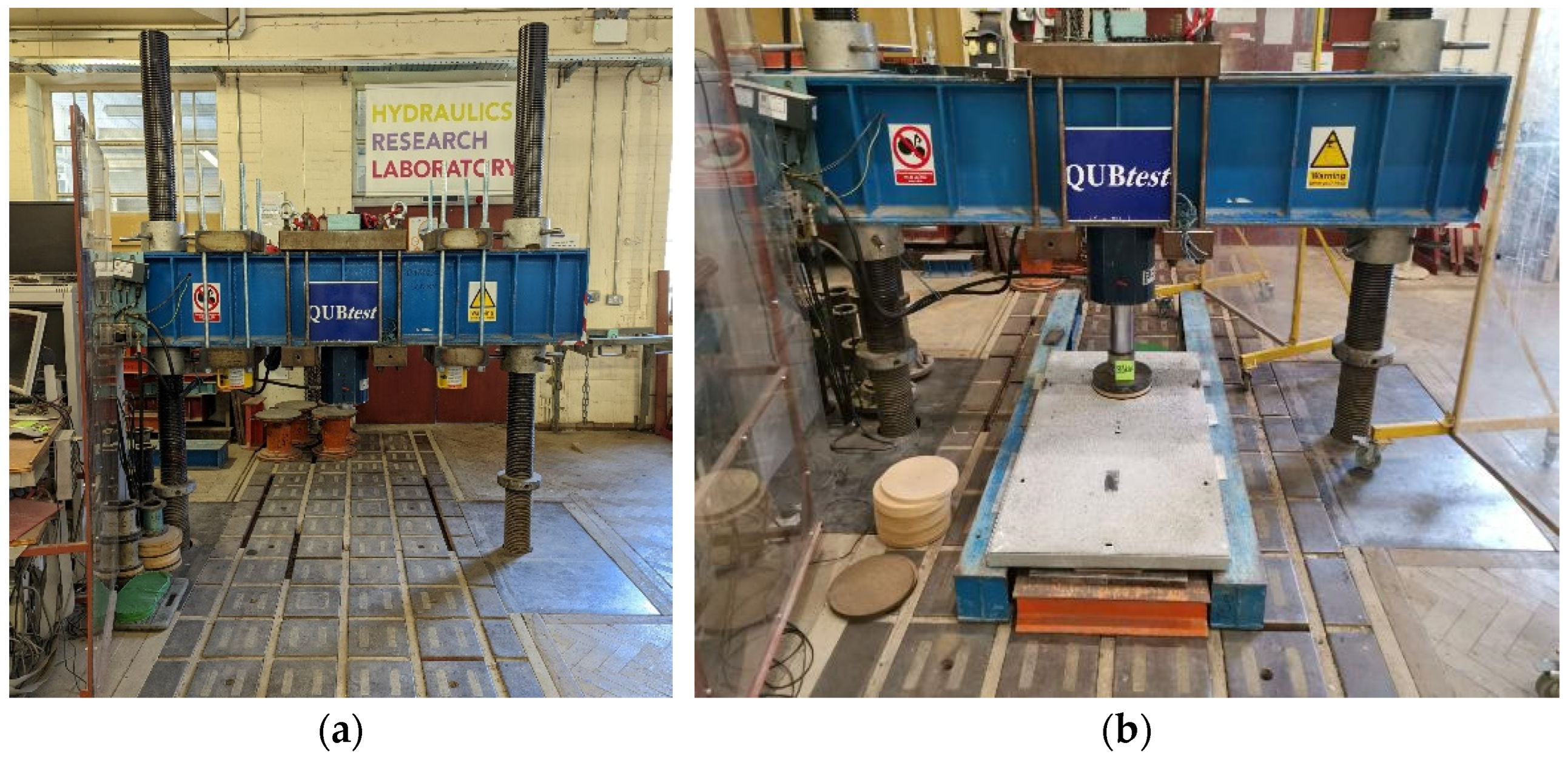


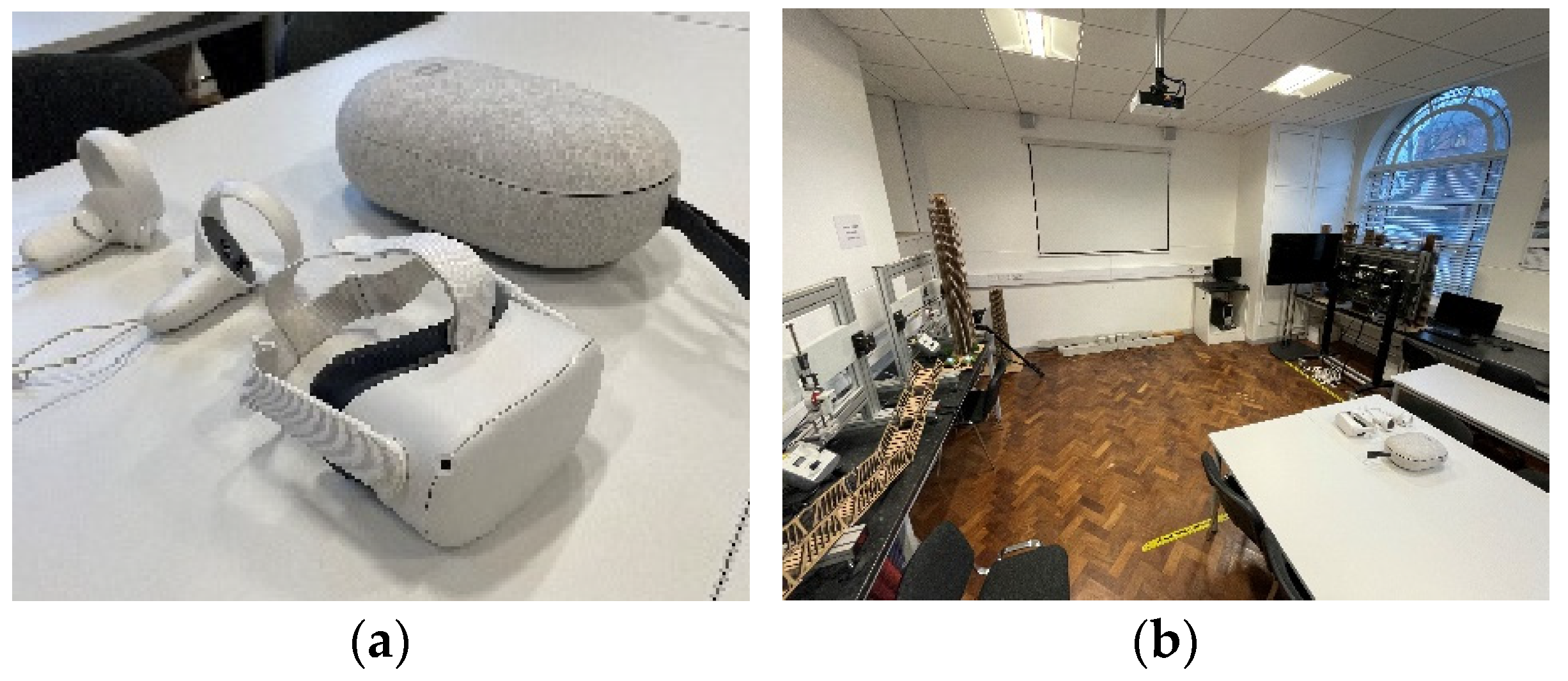
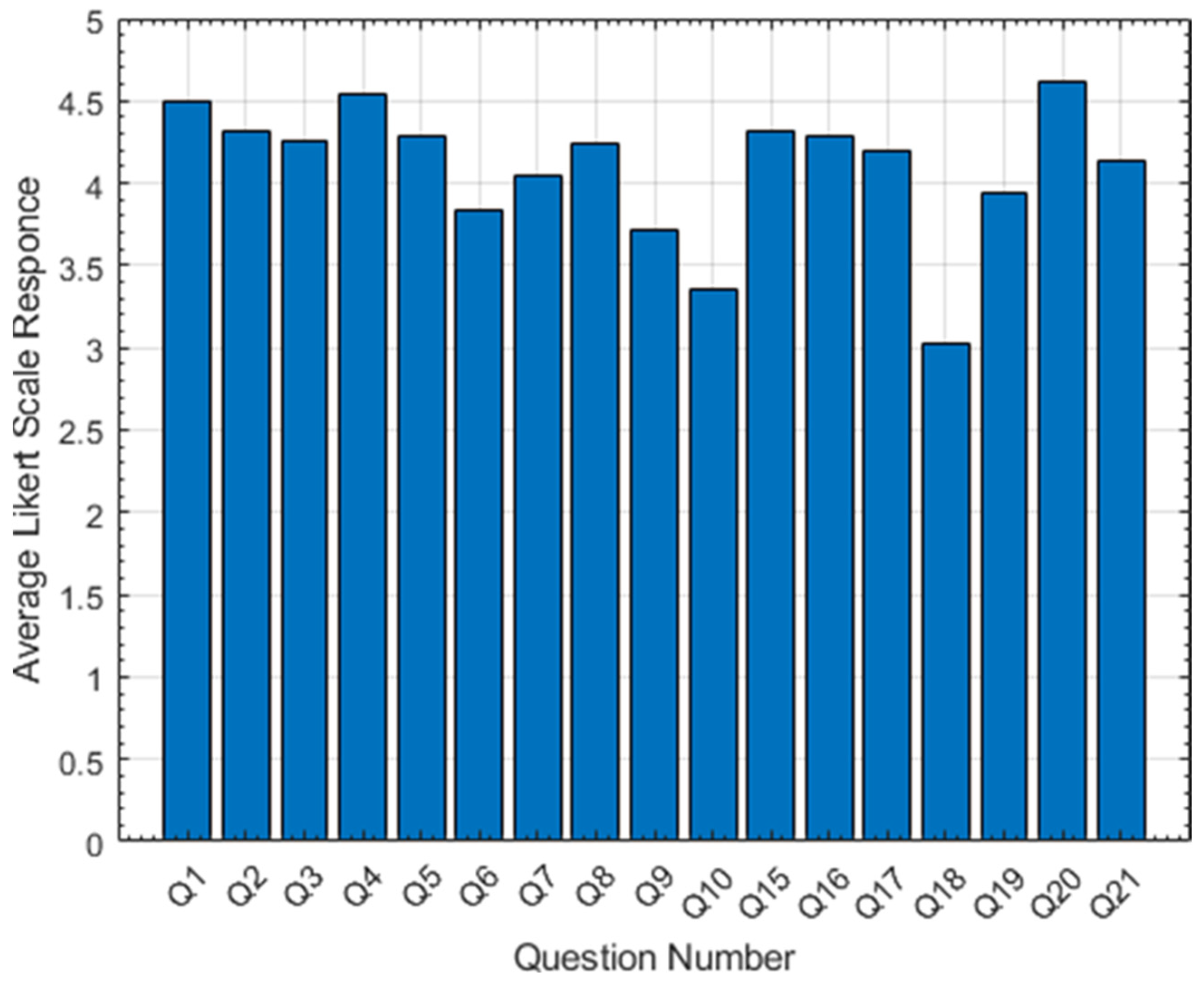
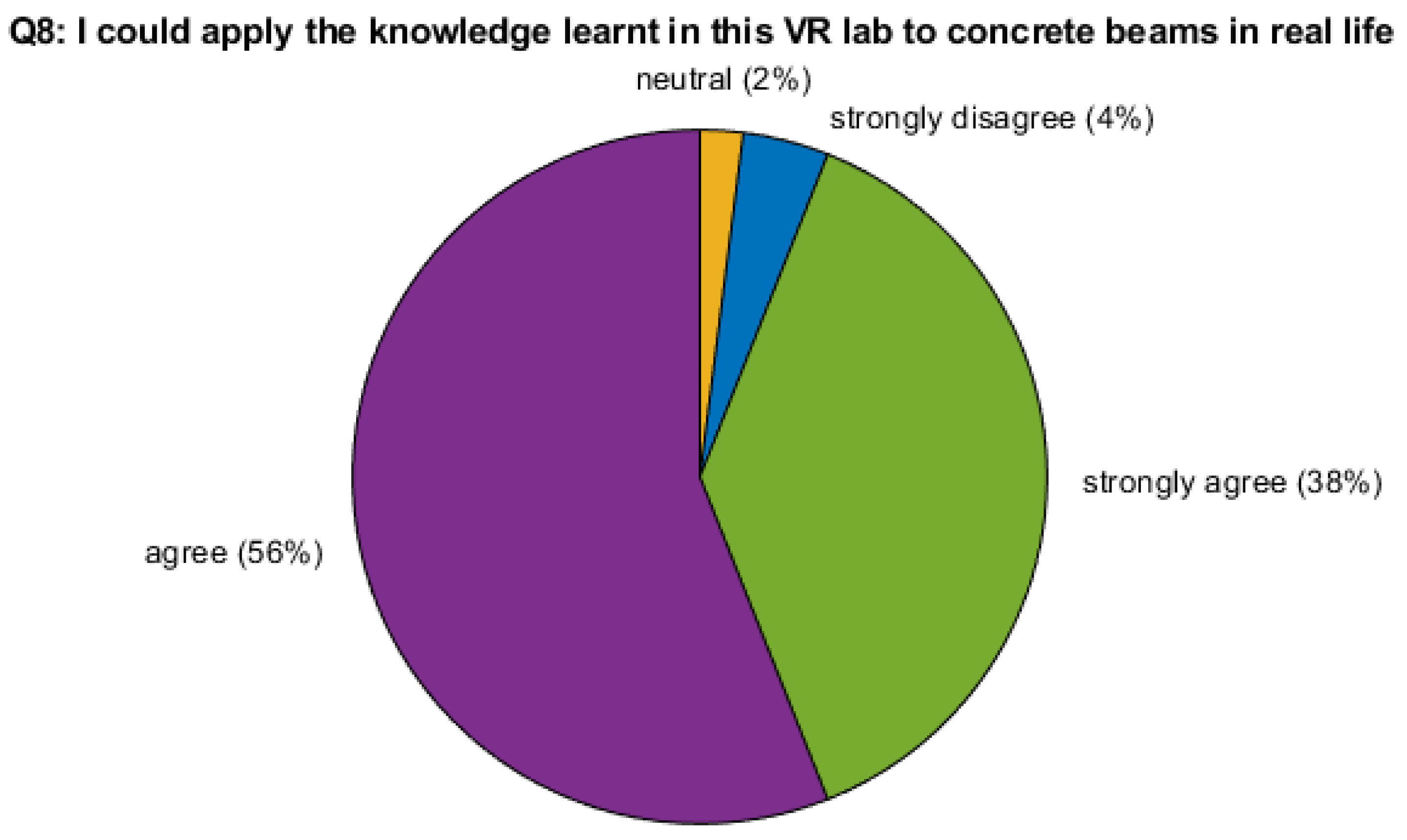
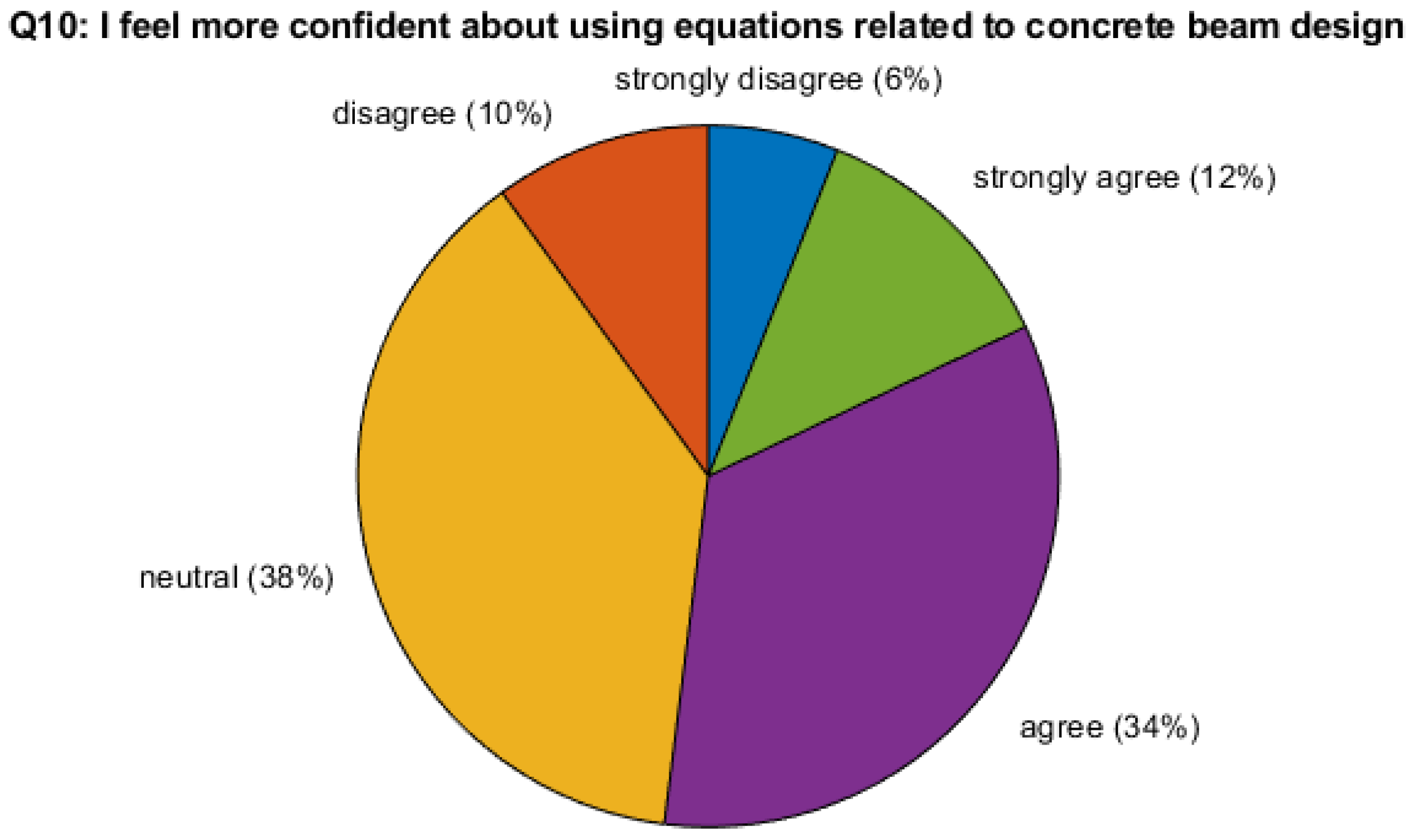
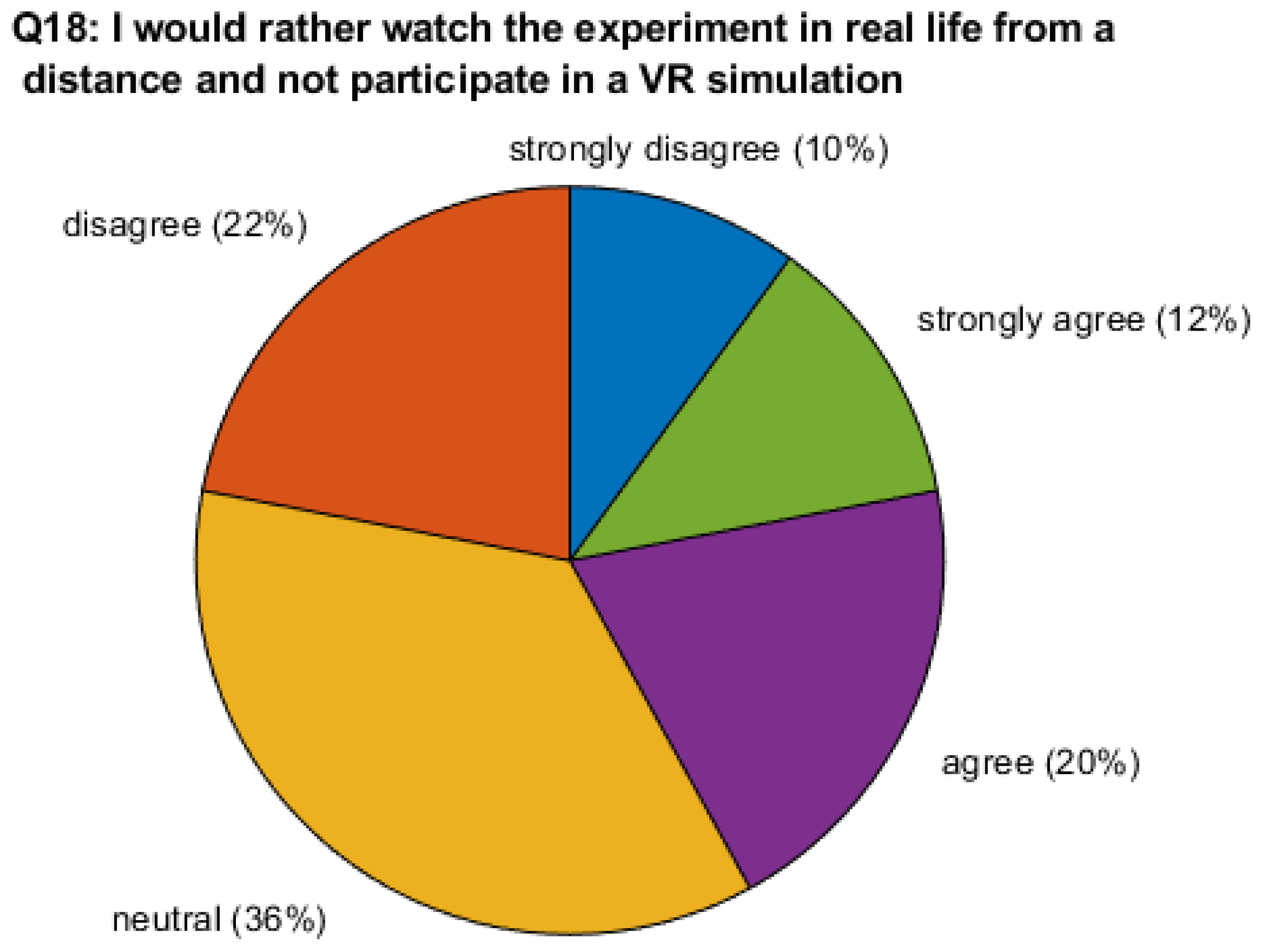
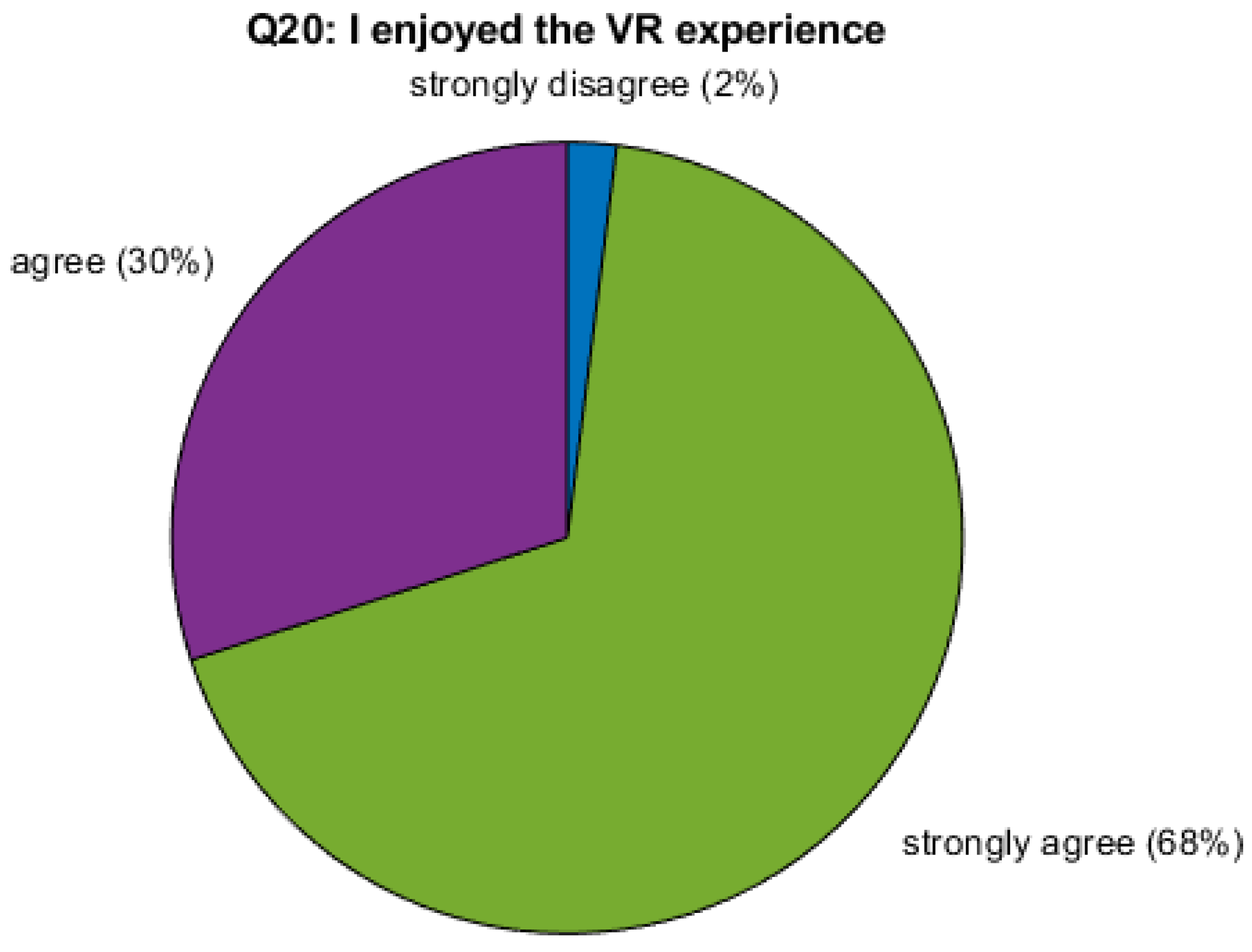

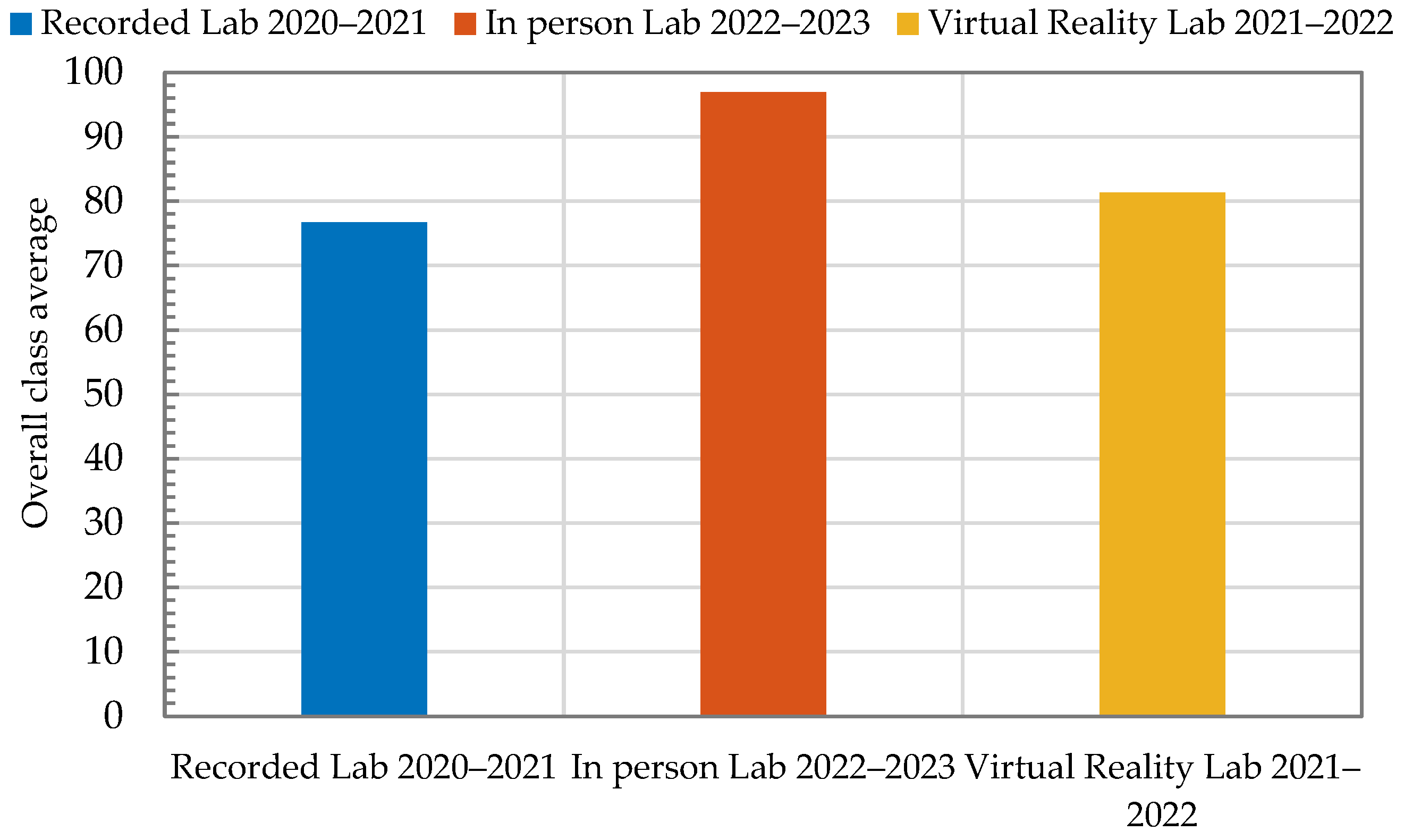
| Characteristic | Categories | |||
|---|---|---|---|---|
| Focus | Research Outcomes | Research Methods | Theories | Applications |
| Goal | Integration | Criticism | Identification of Central Issues | |
| Perspective | Neutral Representation | Espousal of Position | ||
| Coverage | Exhaustive | Exhaustive/Selective | Representative | Central/Pivot |
| Organization | Historical | Conceptual | Methodological | |
| Audience | Specialized Scholars | General Scholars | Practitioners | General Public |
| Question No. | Question |
|---|---|
| 1 | It is clear what the laboratory is aiming to achieve |
| 2 | It is clear how the experiment was set up |
| 3 | The experiment was set up in the same way if done in the physical laboratory |
| 4 | I could ask for help if I needed it |
| 5 | I had the chance to solve problems on my own |
| 6 | I was unsure about what I needed to do |
| 7 | I understand the results obtained |
| 8 | I could apply the knowledge leant in this VR lab to concrete beams in real life |
| 9 | I have a better understanding of concrete beams |
| 10 | I feel more confident about using equations related to concrete beam design |
| 11 | What failure mode was present? |
| 12 | How does increasing the cross section of steel in the beam affect it? |
| 13 | If the area of steel was significantly increased, how would the failure mode change? |
| 14 | Concrete in the beam has very low resistance to tension or compression? |
| 15 | The VR lab in general was easy to follow |
| 16 | The VR lab helped to visualise theory I had been learning about |
| 17 | I found the VR controls easy to get used to |
| 18 | I would rather watch the experiment in real life from a distance and not participate in a VR simulation |
| 19 | I know more about the Dartec actuator which I am normally, not able to use |
| 20 | I enjoyed the VR experience in general |
| 21 | I would like to do some laboratories in VR like this more often |
| 22 | What Civil Engineering year are you in? |
| 23 | Have you completed the physical beam testing lab; this experience recreates? |
| Q11 | Q12 | Q13 | Q14 |
|---|---|---|---|
| ‘Explosive’ | ‘The beam will be stronger’ | ‘Less explosive’ | ‘Tension’ |
| ‘Tensile failure’ | ‘Higher tensile resistance’ | ‘Less sudden’ |
Disclaimer/Publisher’s Note: The statements, opinions and data contained in all publications are solely those of the individual author(s) and contributor(s) and not of MDPI and/or the editor(s). MDPI and/or the editor(s) disclaim responsibility for any injury to people or property resulting from any ideas, methods, instructions or products referred to in the content. |
© 2023 by the authors. Licensee MDPI, Basel, Switzerland. This article is an open access article distributed under the terms and conditions of the Creative Commons Attribution (CC BY) license (https://creativecommons.org/licenses/by/4.0/).
Share and Cite
McCloskey, D.W.; McAllister, E.; Gilbert, R.; O’Higgins, C.; Lydon, D.; Lydon, M.; McPolin, D. Embedding Civil Engineering Understanding through the Use of Interactive Virtual Reality. Educ. Sci. 2024, 14, 6. https://doi.org/10.3390/educsci14010006
McCloskey DW, McAllister E, Gilbert R, O’Higgins C, Lydon D, Lydon M, McPolin D. Embedding Civil Engineering Understanding through the Use of Interactive Virtual Reality. Education Sciences. 2024; 14(1):6. https://doi.org/10.3390/educsci14010006
Chicago/Turabian StyleMcCloskey, Daniel William, Emily McAllister, Ryan Gilbert, Connor O’Higgins, Darragh Lydon, Myra Lydon, and Daniel McPolin. 2024. "Embedding Civil Engineering Understanding through the Use of Interactive Virtual Reality" Education Sciences 14, no. 1: 6. https://doi.org/10.3390/educsci14010006






